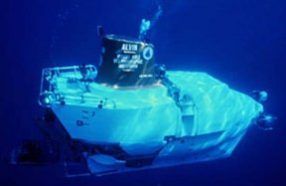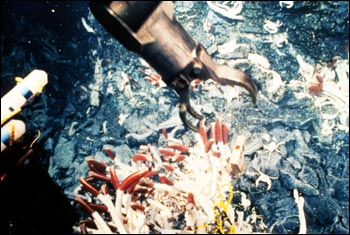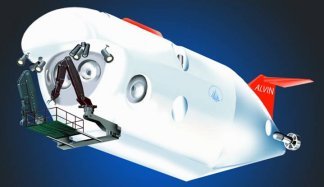Explorer of the extreme deep
A new project to build an improved research sub aims to shed light on the mysterious ocean depths.
By Emily Sohn
It’s dark at the bottom of the ocean. It’s cold down there, too. There’s no air to breathe. The water pressure is crushing. There may be creatures that could harm you.
Let’s face it: The deep sea can be an unpleasant place.
Nonetheless, the watery depths hold an irresistible allure for many people. Enormous squid mingle with fantastic sponges, glowing shrimp, and fat worms. Black plumes bubbling out of the seafloor might hold the secret to the origins of life on Earth.
 |
|
A temperature probe is placed in a black plume of superheated fluid. Such “black smokers” have been found at many underwater vents around the world.
|
| © Woods Hole Oceanographic Institution |
Oceans cover more than two-thirds of our planet. Yet, just a small fraction of the underwater world has been explored.
A new project aims to shed additional light on the ocean depths.
Scientists at the Woods Hole Oceanographic Institution (WHOI) in Massachusetts are building an underwater vehicle that will carry explorers as deep as 6,500 meters (21,320 feet). The new machine, known as a manned submersible or human-operated vehicle (HOV), will replace another one named Alvin, which has been operating for 40 years but can go down only 4,500 meters (14,764 feet).
Based on the amazing results of Alvin‘s explorations, there’s plenty more down there to be discovered.
Upgrade time
It’s about time for an upgrade, WHOI researchers say.
Alvin has been around for a long time. When it was launched in 1964, the submersible immediately transformed the face of underwater exploration. Suddenly, researchers could make repeated visits to great depths—going far, far deeper than scuba divers carrying their own gear.
 |
|
Alvin underwater.
|
| © Woods Hole Oceanographic Institution |
Since then, Alvin has worked between 200 and 250 days a year, says Daniel Fornari. He’s a marine geologist and director of the Deep Ocean Exploration Institute at WHOI. During its lifetime, Alvin has carried some 12,000 people on a total of more than 4,000 dives.
“It’s really the only submersible that dives on a regular basis every year,” Fornari says. “It makes as many dives as all other deep-diving submersibles in the world put together.”
Alvin can’t get to the deepest point in the ocean, and the new vehicle won’t be able to go there either. This place, the Challenger Deep in the South Pacific, is 10,915 meters (6.8 miles) below sea level. (To get a sense of how deep that is, consider the fact that the tallest point on land, Mt. Everest, is 8,850 meters high. If you could put the base of the mountain at the bottom of Challenger Deep, there would still be more than a mile of water above the mountain.)
By diving as deep as 6,500 meters, however, the new HOV will still be able to explore more than 99 percent of Earth’s seafloor.
Deep vents
Alvin has an amazing record of discovery, playing a key role in various important and famous undersea expeditions.
More than 25 years ago, in 1977, scientists using Alvin found deep-sea hydrothermal vents in a place called the Galapagos Rift.
 |
|
Alvin stretches out a mechanical arm to collect a tubeworm at a hydrothermal vent.
|
| © Woods Hole Oceanographic Institution |
Hydrothermal means “hot water.” It’s a fitting name for the scalding plumes of fluid that gush out of the seafloor in some places deep in the ocean. Temperatures in the plumes can reach 400 degrees Celsius.
The fluid itself contains a unique mixture of minerals and chemicals that support exotic deep-ocean ecosystems of microbes, tubeworms, giant clams, and white crabs.
Today, all sorts of researchers and explorers wait for years to get time on Alvin, says Blee Williams, who worked as an Alvin pilot for 11 years.
During his 300-plus dives on Alvin, Williams has helped biologists collect worms and sponges, chemists gather rocks, and oceanographers map the seafloor and take water samples, among many other projects.
Geologists such as Fornari study underwater volcanoes. They look at ocean ridges to understand how the planet’s surface has changed over time.
In 1986, Alvin provided the first photographs of the steamship Titanic, which sank in the North Atlantic after striking an iceberg in 1912.
Newer, better
A newer, better version of Alvin is bound to reveal even more surprises about a world that is still full of mysteries, Fornari says.
It might also make the job of exploration a little easier. “We take so much for granted on land,” Fornari says. “We can walk around and see with our eyes how big things are. We can see colors, special arrangements. Once you go under the surface of the ocean, you have to work really hard to get the same kinds of information.”
 |
|
This drawing shows what the new submersible’s outside will probably look like.
|
| Illustration by E. Paul Oberlander © Woods Hole Oceanographic Institution |
Size-wise, the new HOV will be similar to Alvin. It’ll be about 27 feet long, roughly the size of a small school bus. The sitting area inside will be a small sphere, about 6 feet wide. Like Alvin, it’ll carry a pilot and two passengers. It will be just as maneuverable.
In most other ways, the new, still-unnamed sub will feature plenty of welcome improvements. It’ll give passengers more opportunities to enjoy the view, for one thing. Alvin has only three windows, called view ports. The new vehicle will have five, with more overlap so that the passengers and the pilot can see the same things.
 |
|
Alvin‘s cramped personnel sphere has room for a pilot and two passengers. The pilot (right) is looking out the forward view port. The scientists observe from side view ports.
|
| © Tom Kleindinst, Woods Hole Oceanographic Institution |
Power and speed will also get major boosts. Alvin can go up and down at a rate of 30 meters every second, and its maximum speed is 2 knots (about 2.3 miles per hour). The new sub will be able to ascend and descend at 44 meters per second. It’ll reach speeds of 3 knots, or 3.5 miles per hour.
Getting to the bottom faster and moving around more quickly will allow researchers to make the most of their limited time underwater. A typical dive lasts just 9 hours. After that, the sub has to come up to a support ship for maintenance and repairs.
Going super-deep comes with added challenges. To withstand the water pressure that comes with 2,000 extra meters of depth, the new vehicle will have a thicker titanium shell and heartier equipment. It’ll carry the latest and greatest cameras and other technology for collecting data.
Exciting possibilities
Scientists are excited about the possibilities that the new Alvin will offer.
 |
|
The research vessel Atlantis was designed to handle Alvin and various other deep-sea exploration vehicles.
|
| © Woods Hole Oceanographic Institution |
“It will open up new horizons,” Fornari says. “It’ll give us a much better understanding of features and areas that we previously have not been able to go to.”
It should be an exciting ride for the people who get to experience the new sub, too.
Dive after dive on Alvin, Williams says, he saw scientists go speechless at the wonders of being on the other side of the fishbowl. There are few words to express how amazing the view is at the bottom of the sea, he says.
For most of his passengers, it was a lifetime of dreams come true. One of his favorite dives involved astronaut Kathy Sullivan. “She was the first woman to walk in outer space,” Williams says. “She was still like a kid when she went to the bottom of the ocean.”
Ready to sign up for classes to become a submersible pilot?
Williams recommends a healthy interest in all sorts of science and a willingness to learn new things all the time. No two days with Alvin were ever the same, he says.
Being good with tools and machinery is also important, Williams adds. Alvin required a large amount of daily maintenance, which included completely taking it apart and rebuilding it periodically.
“As an engineer for Alvin,” Williams says, “you never knew how you were going to be challenged.”
To be ready in time to ride in the shiny new vehicle, you’ll probably want to start studying right away. It’s set to launch in 2008.
Going Deeper:
Alvin Facts
By April 24, 2004, the deep-sea submersible Alvin had
- completed 4,012 dives.
- reached a total depth of 8,339,919 meters (2,079 meters per dive).
- spent 27,658 hours submerged (6.89 hours per dive).
- carried a total of 12,029 persons.
Source: Woods Hole Oceanographic Institution







